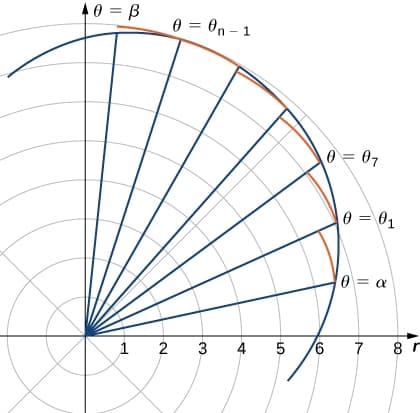Consider a curve defined by the function \(r=f(θ)\), where \(θ\) is in radians and \(α≤θ≤β\). Our first step to find the area is to partition the interval \([α,β]\) into \(n\) equal-width subintervals. The width of each subinterval is given by the formula \(Δθ=(β−α)/n\), and the ith partition point \(θ_i\) is given by the formula \(θ_i=α+ i Δθ \). Each partition point \(θ=θ_i\) defines a line with slope \(\tan(θ_i)\) passing through the pole as shown in the following graph.

The area of a part of a circle is:
\[\frac{θ r^2}{2}\]
This means the area of a partition would be:
\[\frac{(f(θ))^2}{2} Δ θ\]
This means the total area between \(α\) and \(β\):
\[A \approx \sum_{i=1}^n \frac{(f(θ_i^*))^2}{2} Δθ\]
The angle \(θ_i^*\) is an angle in the interval \([θ_{i-1},θ_i]\). If we let \(n\) go to infinity:
\[A = \lim_{n \to \infty} \sum_{i=1}^n \frac{(f(θ_i^*))^2}{2} Δθ = \int^β_α \frac{1}{2} [f(θ)]^2 dθ \]